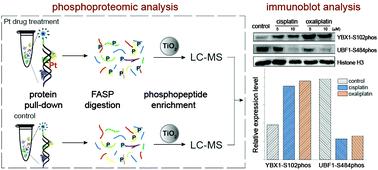当前位置:
X-MOL 学术
›
Metallomics
›
论文详情
Our official English website, www.x-mol.net, welcomes your
feedback! (Note: you will need to create a separate account there.)
Proteomic analysis of cisplatin- and oxaliplatin-induced phosphorylation in proteins bound to Pt–DNA adducts
Metallomics ( IF 2.9 ) Pub Date : 2020-10-26 , DOI: 10.1039/d0mt00194e Xin Yuan 1 , Wanjun Zhang , Yafeng He , Jian Yuan , Dongfan Song , Hao Chen , Weijie Qin , Xiaohong Qian , Hanyang Yu , Zijian Guo
Metallomics ( IF 2.9 ) Pub Date : 2020-10-26 , DOI: 10.1039/d0mt00194e Xin Yuan 1 , Wanjun Zhang , Yafeng He , Jian Yuan , Dongfan Song , Hao Chen , Weijie Qin , Xiaohong Qian , Hanyang Yu , Zijian Guo
Affiliation

|
Cisplatin and oxaliplatin are widely used anti-tumour chemotherapeutic agents with different spectra of activity. The therapeutic efficacy of such platinum-based drug is believed to, at least in part, result from formation of Pt–DNA adducts, followed by DNA damage response and ultimately apoptosis. However, it remains unclear whether these DNA lesions caused by cisplatin and oxaliplatin elicit distinct reactions in cellular signaling pathways. Here, a label-free comparative proteomic study was performed to profile the protein phosphorylation patterns using Pt–DNA probes with different ligand identities and geometries. Phosphorylated proteins recognizing different cisplatin- and oxaliplatin–DNA lesions were enriched and analyzed on LC-MS/MS. Proteomic analysis revealed that cisplatin mainly affected proteins involved in mRNA processing, while chromatin organization and rRNA processing are two major biological processes influenced by oxaliplatin. Changes to site-specific phosphorylation levels of two proteins YBX1 and UBF1 were also validated by Western blotting. In particular, platinum drug treatment in colon and liver cancer cell lines down-regulated S484 phosphorylation of UBF1, which is an essential transcription factor responsible for ribosomal DNA transcription activation, implying that inhibition of ribosome biogenesis might be involved in the cytotoxic mechanism of platinum drugs. Collectively, these results directly reflected distinct protein phosphorylation patterns triggered by cisplatin and oxaliplatin, and could also provide valuable resources for future mechanistic studies of platinum-based anti-tumour agents.
中文翻译:

顺铂和奥沙利铂诱导的与 Pt-DNA 加合物结合的蛋白质磷酸化的蛋白质组学分析
顺铂和奥沙利铂是广泛使用的抗肿瘤化疗药物,具有不同的活性谱。这种铂类药物的治疗功效被认为至少部分是由于 Pt-DNA 加合物的形成,随后是 DNA 损伤反应并最终导致细胞凋亡。然而,尚不清楚这些由顺铂和奥沙利铂引起的 DNA 损伤是否在细胞信号通路中引起不同的反应。在这里,进行了一项无标记的比较蛋白质组学研究,以使用具有不同配体身份和几何形状的 Pt-DNA 探针来分析蛋白质磷酸化模式。在 LC-MS/MS 上富集和分析了识别不同顺铂和奥沙利铂 DNA 损伤的磷酸化蛋白。蛋白质组学分析表明,顺铂主要影响参与 mRNA 加工的蛋白质,而染色质组织和rRNA加工是受奥沙利铂影响的两个主要生物学过程。蛋白质印迹法也验证了两种蛋白质 YBX1 和 UBF1 的位点特异性磷酸化水平的变化。特别是,铂类药物在结肠癌和肝癌细胞系中的治疗下调了 UBF1 的 S484 磷酸化,UBF1 是负责核糖体 DNA 转录激活的重要转录因子,这意味着对核糖体生物发生的抑制可能与铂类药物的细胞毒机制有关. 总的来说,这些结果直接反映了顺铂和奥沙利铂触发的不同蛋白质磷酸化模式,也可以为未来铂类抗肿瘤药物的机理研究提供宝贵的资源。
更新日期:2020-11-06
中文翻译:

顺铂和奥沙利铂诱导的与 Pt-DNA 加合物结合的蛋白质磷酸化的蛋白质组学分析
顺铂和奥沙利铂是广泛使用的抗肿瘤化疗药物,具有不同的活性谱。这种铂类药物的治疗功效被认为至少部分是由于 Pt-DNA 加合物的形成,随后是 DNA 损伤反应并最终导致细胞凋亡。然而,尚不清楚这些由顺铂和奥沙利铂引起的 DNA 损伤是否在细胞信号通路中引起不同的反应。在这里,进行了一项无标记的比较蛋白质组学研究,以使用具有不同配体身份和几何形状的 Pt-DNA 探针来分析蛋白质磷酸化模式。在 LC-MS/MS 上富集和分析了识别不同顺铂和奥沙利铂 DNA 损伤的磷酸化蛋白。蛋白质组学分析表明,顺铂主要影响参与 mRNA 加工的蛋白质,而染色质组织和rRNA加工是受奥沙利铂影响的两个主要生物学过程。蛋白质印迹法也验证了两种蛋白质 YBX1 和 UBF1 的位点特异性磷酸化水平的变化。特别是,铂类药物在结肠癌和肝癌细胞系中的治疗下调了 UBF1 的 S484 磷酸化,UBF1 是负责核糖体 DNA 转录激活的重要转录因子,这意味着对核糖体生物发生的抑制可能与铂类药物的细胞毒机制有关. 总的来说,这些结果直接反映了顺铂和奥沙利铂触发的不同蛋白质磷酸化模式,也可以为未来铂类抗肿瘤药物的机理研究提供宝贵的资源。











































 京公网安备 11010802027423号
京公网安备 11010802027423号